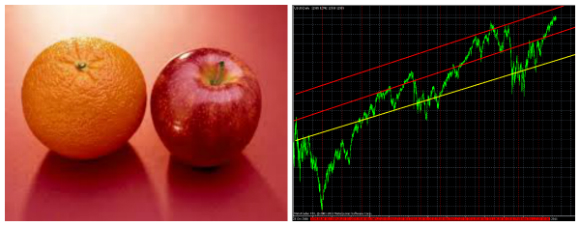By Colin Whitlow
In this guest Filmonomics post adapted from his initial think pieces on the Cinema Research Institute (CRI) blog, CRI 2014 fellow Colin Whitlow explains why the film industry would benefit from a dedicated performance index – and how he is approaching building just such a valuable tool.
The film industry is weakened by the absence of an objective, transparent measuring tool for would-be film investors. Many mature industries have created an index to help the investment community get a read on the sector’s financial climate. The Dow Jones Industrial Average, a price-weighted average of 30 significant stocks traded on the New York Stock Exchange and the Nasdaq, serves as a real-time proxy for mainstream financial market activity and economic health. The Case-Shiller Home Price Indices, calculated and kept monthly by the statistical rating organization Standard & Poor, are well-respected indicators of real estate performance in the U.S. Even esoteric asset classes such as fine wine and collectible art have their own benchmarks. But the film industry has no such like-for-like barometer.

Some risk prone investors become involved in films with virtually no useful financial information to go on, making a hopeful jump into the abyss with the belief that the journey will have been fun regardless of its outcome. A small group of experienced investors understand how to create assurances for themselves, increasing their chances of financial success. The overwhelming majority of investors, however, choose not to invest in film at all, finding alternative vehicles that provide greater transparency into the mechanisms related to financial returns and the set of past ‘comparables’. Both filmmakers and investors suffer from the continued opacity surrounding investment opportunities.
Under the belief that the presence of an objective film index might help alleviate this issue and lead to more sustainable and intentional investment practices, I am researching methodologies through which such an index could be made. The challenges, data types and partners that would need to be involved in such an undertaking are being identified – and so too the real-world applications for such a measuring tool in an industry whose habits are slow to change.
First thing’s first – what is an index really? In simple language, it’s a set of investments combined to form a score that can be compared at various places in time relative to its own base value. Line graphs depicting stock performances over time are fairly standard visual indicators commonly used to aid the decision-making process of investors. However, there is no simple or obvious way to make a similar tool related to the performance of film investment – at least not without setting a few things straight.
There are a plethora of ways in which films are unlike stocks. Here are just some:
· Stocks hold value that is theoretically ongoing, whereas the revenue-generating life of a film is finite. A film index needs a standard basis to gather revenue information.
· Companies available for trade on the public market are highly regulated while even studios and production companies owned by publicly traded conglomerates do not disclose financial returns on a per-film basis. A useful film index requires data its users trust.
· Stock markets allow for high volumes of ongoing trading from many different sources, which all fall into a standardized system, whereas films typically require funding at the front end from a small number of sources and generate revenue from a widely diverse and disparate set of streams during specific windows.
Luckily, there exist other indices related to investments that I find much more analogous to films. One such index is Liv-ex, a global marketplace for buyers and sellers of fine wine. In studying the Liv-ex system, it becomes clear that the practical and philosophical questions its founders tackled are highly applicable to the construction of a film index.

In the film Sideways, the character Miles Raymond reveals the secret to wine-tasting: “Let me show you how this is done. First thing, hold the glass up and examine the wine against the light. You’re looking for color and clarity.” Having scrutinized the wine appearance for its color density, he then tells his friend to “really get your nose right in there” and sniff all the aromas and flavors. When it comes to evaluating the wine industry as a whole, other critical elements come into play that require different sensory skills.
1. Defining the criteria for inclusion
As Liv-ex’s director, James Miles, said, “To be regarded as a fine wine, a wine must have the potential to both improve in bottle and appreciate in value, and be actively sought after in the secondary market. To satisfy this requirement, a wine must have a long track record (often centuries rather than decades) and have received strong critical acclaim.”
It is essential that a film index articulate a fine level of specificity in setting the boundaries that demarcate what films it includes. There are many different types of boundaries one might choose. The key will be to select a rubric that is meaningful for investors and filmmakers alike and that produces a score that can be used to make projections beyond the list of included films. Is an ongoing slate of films made by 25 film producers meaningful? What about a set of sub-indices built within genres? Should the budget of the film be a factor? The length? And with each question come practical considerations regarding the ability to get specific data.
2. Defining the index’s value
In Liv-ex’s case, James Miles points to the index as a tool that investors can use to calibrate fine wine as an asset class within their portfolio, comparable to others such as gold and real estate. He points to the ability for “growers to finance their crop, which for fine wine is often not ready for drinking for a decade or more” – providing an enhanced level of stability for crop producers that would be the envy of most independent content producers. The transparency of an index also addresses other challenges involved in wine-making: the burdens of transaction fees leading to low liquidity and slow working capital cycle times throughout the industry. Again, the analogy with filmmaking is all too obvious.

Constructing a useful film index amidst a constant fluctuation of industry conditions feels a bit like drawing a box in the sand on a windy beach. Any grains of data that fall within the box would be included in the index because of their perceived usefulness toward projecting future performance. However, with current viewing habits and production and distribution practices continually shifting, even the outline of that box is subject to change.
In defining the boundaries of that sandbox two initial considerations come into play: normalizing the index scoring system and distinguishing films according to their level of risk.
Normalizing Film Data
Simply looking at box office performance at a given point in time tells you very little. It tells you something about the strength of titles currently in theaters. It tells you a lot about the importance of the release cyclicality (i.e., Thanksgiving and July 4 weekends are huge overall ticket sellers), which then becomes a self-fulfilling prophecy for distributors planning their release timing. Film investors fully expect to see ticket sales spike at certain times because that’s what they’ve consistently done historically. But they need more context to understand more about the performance of specific titles and categories.
Scoring this year’s data against the same week from the year prior yields a little more information. But I’m of the belief that comparing the current year to anything much further back than the previous year would begin to warp the conclusions one might draw. Consider how much Netflix, HBO Go, Hulu and other platforms have shifted viewing patterns over the last two years alone. The recent habituation of social media habits into our daily entertainment lives only adds to that data warp. To blindly weigh 2013’s July box office performance against 2005’s is to compare two very different environments and would confuse or mislead any investor trying to draw meaningful conclusions.
Other forms of normalization may also need to be factored in. For instance, how much should we account for ticket-price inflation and/or remove premium-priced 3D titles from consideration. What about more nuanced factors like macro weather patterns and competing events such as sports or even news?
In the end, simply comparing one year to another provides limited information for many reasons. Release patterns are in constant motion. Aside from several standard big weekends, which are likely to remain bellwether box office indicators, releasing a specific film during a specific week tends to be based on a host of considerations unique to that period. Not to mention the fact that holidays don’t appear as the same “week” each year. When viewed as a graph, this calendar variation will create peaks and valleys that don’t make sense in comparing two years. Such a comparison also doesn’t speak to the actual volume of revenue earned. Clearly, while scoring one year against another can provide certain information, it is only one tool in the toolbox – and not necessarily even the most accurate of the available gauges.
Risk categories
A common factor used to categorize various investments is level of risk. Risk level is a core consideration for investors, who need to be able to compare other holdings in their portfolio with the one under consideration and weigh the entire basket against their overall risk tolerance. Film investors attempt to identify these same risk characteristics as they relate to specific projects. Sophisticated film investors attempt to create diverse portfolios to try to ensure several flops don’t overshadow the hits. A film portfolio, typically referred to as a slate, is not a new idea. However, successful film slates are not nearly as common as lauded mutual funds because visibility into specific films’ actual level of risk is characteristically not that great.
Putting aside for now with the limitations of identifying real projects to make up a film slate, let’s use stocks as a template for broad categories of risk – and see whether these have resonance in the film world. Here are some archetypal risk baskets:
· Income Stocks: considered the least risky category of stocks, income stocks are typically thought of as having slightly higher risk and return potential than bonds. Utility stocks are in this category, since investors have faith that people will continue to need things like electricity and water.
· Value Stocks: those that have historically been a good investment and are thought to be undervalued at their current price. The idea is that buying undervalued shares allows you to enjoy additional upside as the price returns to its proper level.
· Growth Stocks: investors expect a strong return on equity with these stocks that strong historical and projected growth rates. Many technology and alternative energy stocks are placed in this category, assuming they’re at a scale that offers reasonably low volatility and established enough to have historical data to reflect a trend of high growth.
· Emerging Markets: at the riskier end of the investment spectrum include smaller companies with no proven track record or significant market presence and companies from emerging markets. These investments are exposed to a higher than average level of volatility due to lack of liquidity, political and currency issues that might disproportionately affect them and generally uneven growth, often due to their small scale.
I believe there are some correspondence to be drawn between risk categorization in films and those for stocks. Translating these definitions from one investment domain to the other may help me in drawing lines around films for my own index in ways that will help portfolio-building. Once those boundaries are clearly defined, determining the content to be included within becomes much easier. It’s worth noting here that everything from the Dow to Liv-ex has gone through periods of revision. The same will be inevitably true of a Film Index. But with each such iteration will also come increasing clarity in the film investment process. The journey will be as illuminating as the end-result.





